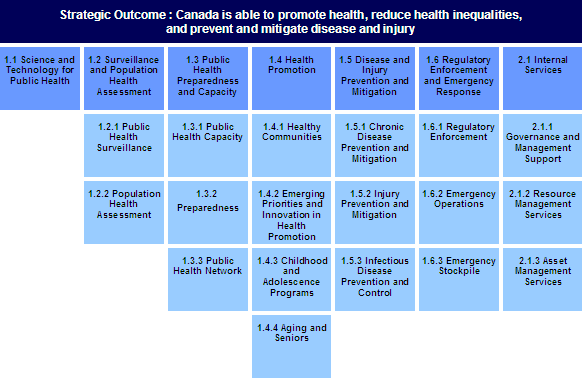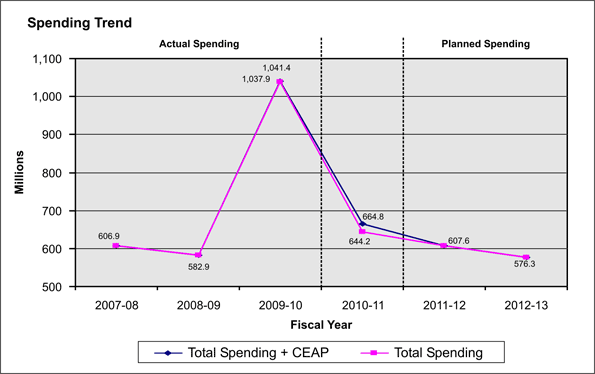Common menu bar links
Breadcrumb Trail
ARCHIVED - Public Health Agency of Canada
 This page has been archived.
This page has been archived.
Archived Content
Information identified as archived on the Web is for reference, research or recordkeeping purposes. It has not been altered or updated after the date of archiving. Web pages that are archived on the Web are not subject to the Government of Canada Web Standards. As per the Communications Policy of the Government of Canada, you can request alternate formats on the "Contact Us" page.
Minister's Message
 I am pleased to present the Public Health Agency of Canada's 2010-11 Report on Plans and Priorities. The health of Canadians and their access to a strong and effective health care system are among the highest priorities for the Government of Canada. In my role as Minister of Health, I recognize the important contributions the Agency will continue to make towards these priorities.
I am pleased to present the Public Health Agency of Canada's 2010-11 Report on Plans and Priorities. The health of Canadians and their access to a strong and effective health care system are among the highest priorities for the Government of Canada. In my role as Minister of Health, I recognize the important contributions the Agency will continue to make towards these priorities.
Among the most visible of these contributions are the Agency's efforts in infectious disease prevention and control. The H1N1 flu pandemic dominated the federal health agenda in 2009; however, thanks to years of collaboration and cooperation between the Agency and its many partners, comprehensive pandemic plans were in place. Looking forward, these plans ensure that the Agency will continue to lead the federal response to the H1N1 flu and other pandemics. By employing experience gained from public health events and mass gatherings, such as the 2010 Olympics and the 2010 G8/G20 Leaders Summit, the Agency will continue to strengthen its emergency preparedness.
Collaborative efforts to promote public health and prevent chronic disease are effective ways to reduce the burden on the health care system. The Agency will continue to play a leading role in helping to prevent and mitigate the prevalence of diabetes and heart disease, as well as obesity and other key risk factors. Working closely with stakeholders, the Agency will fund the design and implementation of Canada's first national study on neurological diseases to increase knowledge of these diseases and how they affect Canadians. The Agency will also work to improve the respiratory health of Canadians by advancing the National Lung Health Framework. As well, the Agency will support innovative interventions focused on the mental health of vulnerable Canadians to inform the future development of policies and programs.
With this Report, I am confident that the Agency will demonstrate accountability, efficiency and effectiveness in helping to protect the health and safety of Canadians.
Minister of Health
Message from the Chief Public Health Officer
 Public health is the foundation of a prosperous society. The Public Health Agency of Canada works hand in hand with national and international partners to achieve a vision of healthy Canadians and communities in a healthier world.
Public health is the foundation of a prosperous society. The Public Health Agency of Canada works hand in hand with national and international partners to achieve a vision of healthy Canadians and communities in a healthier world.
Public health often receives the greatest attention during high-profile emergencies such as the H1N1 flu pandemic. Working with partners at all levels, the Agency's response to the pandemic has been multi-faceted: helping secure enough vaccine for every Canadian who wants and needs it; leading surveillance activities; and providing Canadians with information to make well-informed decisions, among many other activities. The Agency will continue to work collaboratively to integrate knowledge and experience gained in leading the Federal response to H1N1 to strengthen preparedness for future pandemics or other emerging infectious disease outbreaks.
The Agency also works to promote and protect the health and safety of Canadians in other areas. Leadership will continue to be demonstrated in health promotion programs for children, youth and seniors to address emerging issues. In accordance with the recommendations made in the Report of the Independent Investigator into the 2008 Listeriosis Outbreak, the Agency will work closely with Health Canada and the Canadian Food Inspection Agency to address systemic challenges in leadership, preparedness, planning for and communicating about food safety issues. As well, by implementing the Human Pathogens and Toxins Act, the Agency will monitor Canadian laboratories to ensure consistency in the safe handling of pathogenic agents and toxins, to protect Canadians from the risks posed by anyone who would intentionally misuse them and to enhance national security.
Through this Report on Plans and Priorities, the Agency has articulated its agenda and will be making progress towards its vision of healthier Canadians and communities in a healthier world.
Chief Public Health Officer
Section I – Overview
1.1 Summary Information
Raison d'être
Public health involves the organized efforts of society to keep people healthy and to prevent injury, illness and premature death. It includes programs, services and policies that protect and promote the health of all Canadians. In Canada, public health is a responsibility that is shared by the three levels of government, the private sector, non-government organizations, health professionals and the public.
In September 2004, the ![]() Public Health Agency of Canada (the Agency) was created within the federal
Public Health Agency of Canada (the Agency) was created within the federal ![]() Health Portfolio to deliver on the Government of Canada's commitment to increase its focus on public health in order to help protect and improve the health and safety of all Canadians and to contribute to strengthening the health care system. The Agency's activities focus on preventing and controlling chronic and infectious diseases, preventing injuries and preparing for and responding to public health emergencies.
Health Portfolio to deliver on the Government of Canada's commitment to increase its focus on public health in order to help protect and improve the health and safety of all Canadians and to contribute to strengthening the health care system. The Agency's activities focus on preventing and controlling chronic and infectious diseases, preventing injuries and preparing for and responding to public health emergencies.
Roles and Responsibilities
The Agency has the responsibility to:
- Contribute to the prevention of disease and injury, and to the promotion of health;
- Provide federal leadership and accountability in managing public health emergencies;
- Serve as a central point for sharing Canada's expertise with the rest of the world and for applying international research and development to Canada's public health programs; and
- Strengthen intergovernmental collaboration on public health and facilitate national approaches to public health policy and planning.
In December 2006, the Public Health Agency of Canada Act came into force, giving the Agency the statutory basis to continue fulfilling these roles.
Strategic Outcome and Program Activity Architecture (PAA)
To effectively pursue its mandate, the Agency aims to achieve a single Strategic Outcome supported by the Program Activity Architecture (PAA) summarized below.

In 2009-10, the Agency continued its work on the implementation of the Management, Resources and Results Structure Policy which included the revision and approval of the Strategic Outcome and PAA as well as the development of an associated Performance Measurement Framework (PMF) and governance structure.
The objectives of this modernization initiative were to: ensure alignment of the Strategic Outcome and the PAA with the Agency's mandate; improve the clarity and measurability of the Strategic Outcome; enhance alignment of Program Activities with the Strategic Outcome; and develop a PMF that would provide more detailed, objective performance measurement information to support the review, assessment and continuous improvement of programs.
PAA Crosswalk
The following crosswalk compares the old to the new PAA and shows the redistribution of financial resources in the 2009-10 Main Estimates. To highlight the importance of research, testing and surveillance in public health, two new program activities were established: Science and Technology for Public Health, and Surveillance, and Population Health Assessment. The new PAA is designed to enable effective planning and reporting at both strategic and operational levels.
| From 2009-10 PAA (columns) | Health Promotion | Chronic Disease Prevention and Control | Infectious Disease Prevention and Control | Emergency Preparedness and Response | Strengthen Public Health Capacity | Internal Services | Total | |
|---|---|---|---|---|---|---|---|---|
| To new 2010-11 PAA (rows) | ||||||||
| 1.1 | Science and Technology for Public Health | - | - | 46.7 | - | - | - | 46.7 |
| 1.2 | Surveillance and Population Health Assessment | 5.9 | 15.0 | 33.0 | - | - | - | 53.9 |
| 1.3 | Public Health Preparedness and Capacity | - | - | 48.8 | 5.6 | 31.1 | - | 85.5 |
| 1.4 | Health Promotion | 183.9 | - | - | - | - | - | 183.9 |
| 1.5 | Disease and Injury Prevention and Mitigation | 2.9 | 41.5 | 117.4 | - | - | - | 161.8 |
| 1.6 | Regulatory Enforcement and Emergency Response | - | - | 10.5 | 19.8 | - | - | 30.3 |
| 2.1 | Internal Services | 1.8 | 3.8 | 4.9 | 1.4 | - | 74.0 | 85.9 |
| Total | 194.5 | 60.3 | 261.3 | 26.8 | 31.1 | 74.0 | 648.0 | |
Planning Summary
Financial and Human Resources
| 2010-11 | 2011-12 | 2012-13 |
|---|---|---|
| 664.8 | 607.6 | 576.3 |
| 2010-11 | 2011-12 | 2012-13 |
|---|---|---|
| 2,590 | 2,583 | 2,535 |
| Performance Indicator | Target |
|---|---|
| Health-adjusted life expectancy at birth | Canada is among the nations with the highest healthy life expectancy at birth |
| Program Activity | Forecast Spending 2009-10 |
Planned Spending | Alignment to Government of Canada Outcomes | ||
|---|---|---|---|---|---|
| 2010-11 | 2012-12 | 2012-13 | |||
| 1.1 Science and Technology for Public Health | 57.0 | 85.0 | 58.8 | 48.3 | Healthy Canadians |
| 1.2 Surveillance and Population Health Assessment | 56.8 | 58.3 | 58.8 | 57.2 | Healthy Canadians |
| 1.3 Public Health Preparedness and Capacity | 88.9 | 104.1 | 72.0 | 68.0 | Healthy Canadians |
| 1.4 Health Promotion | 184.3 | 178.8 | 177.8 | 177.9 | Healthy Canadians |
| 1.5 Disease and Injury Prevention and Mitigation | 423.9 | 115.7 | 118.4 | 102.3 | Healthy Canadians |
| 1.6 Regulatory Enforcement and Emergency Response | 122.9 | 29.5 | 29.6 | 28.5 | Safe and Secure Canada |
| 2.1 Internal Services | 107.6 | 93.4 | 92.2 | 94.1 | |
| Total | 1,041.4 | 664.8 | 607.6 | 576.3 | |
Contribution of Priorities to the Strategic Outcome
The following table outlines four operational and two management priorities and their links to the PAA and Agency plans.
| A1. Managing Public Health Risks to Canadians | Type: Ongoing | Link to Program Activities (PA's): PA 1.1, 1.2, 1.3, 1.5, 1.6 |
Why is this a priority?
Plans for meeting the priority
|
||
| A2. Promoting the Health of Vulnerable Canadians | Type: Ongoing | Link to Program Activities (PA's): PA 1.2, 1.3, 1.4, 1.5 |
Why is this a priority?
Plans for meeting the priority
|
||
| A3. Public Health Capacity | Type: Ongoing | Link to Program Activities (PA's): PA 1.2, 1.3, 1.5, 1.6 |
Why is this a priority?
Plans for meeting the priority
|
||
| A4. Improving Knowledge Dissemination and Use of Best Practices in Public Health | Type: Ongoing | Link to Program Activities (PA's): PA 1.2, 1.3, 1.4, 1.5, 1.6 |
Why is this a priority?
Plans for meeting the priority
|
||
| B1. Achieving Business Excellence | Type: Previously committed | Link to Program Activities (PA's): PA 2.1 |
Why is this a priority?
Plans for meeting the priority
|
||
| B2. People Management | Type: New | Link to Program Activities (PA's): PA 2.1 |
Why is this a priority?
Plans for meeting the priority
|
||
Risk Analysis
The Agency operates within a changing socio-economic environment domestically and globally. Canada weathered the 2007-2009 global financial crisis well; however, impacts were felt in many communities, including rural, remote, and Northern communities where life expectancies may be shorter than that of average Canadians. The Agency has a role to play in helping to mitigate and reduce health inequalities in Canada by improving the health and safety of disadvantaged and vulnerable Canadians.
Countries worldwide are more dependent on one another, which has resulted in higher international migration,, commerce and travel. This trend increases the likelihood of an infectious disease outbreak and the speed of its transmission. The Agency's experience in responding to the ![]() H1N1 pandemic in Canada will provide knowledge and tools to strengthen surveillance, planning, preparedness and response for future pandemics. In 2010-11, the Agency will integrate this expertise to inform improvements and help define a way forward for other public health events.
H1N1 pandemic in Canada will provide knowledge and tools to strengthen surveillance, planning, preparedness and response for future pandemics. In 2010-11, the Agency will integrate this expertise to inform improvements and help define a way forward for other public health events.
Global food supply chains and demand for lower costs result in food products that are sourced from many different countries, not all of which have robust regulatory systems to protect the public from food-borne illnesses. The Agency will continue working with Health Canada and the Canadian Food Inspection Agency to implement measures to address the recommendations made in the ![]() Report of the Independent Investigator into the 2008 Listeriosis Outbreak.
Report of the Independent Investigator into the 2008 Listeriosis Outbreak.
Coordination and capacity among federal, provincial, territorial, regional and local health authorities is of the utmost importance to enable effective management and response to multi-jurisdictional food-borne illness and infectious disease outbreaks. The Agency will continue to coordinate through strategies that include addressing systemic challenges in leadership, preparedness, planning and communication of food safety issues. The H1N1 flu outbreak will also provide insight for continued improvements.
The Agency will continue to enhance emergency preparedness and response capacity during major events and mass gatherings held in Canada. Accordingly, Agency experience from the ![]() 2010 Olympics and the 2010 G8/G20 Leaders Summit will be used to enhance this capacity for the health and safety of Canadians.
2010 Olympics and the 2010 G8/G20 Leaders Summit will be used to enhance this capacity for the health and safety of Canadians.
Canada's population is aging, which creates new demands on families and potentially greater costs for social programming and healthcare. More study is needed to increase knowledge of the impact of this demographic shift and leverage opportunities. For instance, with an aging population comes a shrinking labour force and increased domestic and international competition for the same scarce resource pool of public health practitioners. To ensure that the Agency will recruit and retain the required public service talent, the Agency will foster a people-oriented workplace in support of ![]() Public Service Renewal by developing and implementing a comprehensive Human Resources (HR) policy framework and an HR Management Framework over the three-year planning horizon. The Agency is committed to strengthening public health capacity to meet the needs of Canadians by working with national and international partners.
Public Service Renewal by developing and implementing a comprehensive Human Resources (HR) policy framework and an HR Management Framework over the three-year planning horizon. The Agency is committed to strengthening public health capacity to meet the needs of Canadians by working with national and international partners.
To establish a common approach to improving risk management across the Agency, an Integrated Risk Management Standard (IRMS), a draft Basic Risk Management Tool and an IRMS Implementation Plan were developed. The IRMS provides the foundation for the use of common terminology within the Agency.
Expenditure Profile
The Agency's spending trend has been relatively stable since 2007-08. However, in 2009-10, Canada experienced an H1N1 influenza outbreak in the Spring and Fall which accounted for most of the additional $458.5M spending. These H1N1 related costs were for the purchase of vaccine ($246M) and outbreak response ($116.2M). Also in 2009-10, the Agency spent $49.7M on the Hepatitis C Health Care Services Program which provides funding to the provinces to compensate for the care of individuals infected with hepatitis C. The next and final payment will occur in 2014-15. As well, the Agency received funding for installation of a new vaccine fill line ($7.1M), to establish a stronger safety and security regime to protect the health of Canadians against the risks posed by the unsafe use and release of human pathogens and toxins in and from Canadian laboratories ($5.3M), to renovate, expand and optimize the space at the Canadian Science Centre for Human and Animal Health (CSCHAH) ($3.5M) and to address the recommendations made in the Report of the Independent Investigator into the 2008 Listeriosis Outbreak ($2.7M).
As many of the items in 2009-10 are one-time funding to address immediate pressures, planned spending is lower by $377.3M in 2010-11. The decrease of $57.2M from 2010-11 to 2011-12 is primarily due to two time-limited projects which are nearing completion: funding for the installation of a new vaccine fill line will be declining as the project nears completion ($20M); and modernizing the CSCHAH ($20.6M) under Canada's Economic Action Plan (CEAP). Other reductions stem from implementation of budget reallocations made in the 2008 Strategic Review process ($6.3M) as well as the planned sunsetting of Agency initiatives under the Clean Air Agenda ($2.5M). The spending decrease of $31.3M from 2011-12 to 2012-13 primarily due to sunsetting of the Canadian HIV Vaccine Initiative ($8.4M), reduced funding levels for the Targeted and Immediate Action on Lung and Neurological Diseases ($7.8M), sunsetting of the funding to implement the recommendations made in the Report of the Independent Investigator into the 2008 Listeriosis Outbreak ($7.6M), and completion of the Influenza Vaccine Fill Line Initiative ($5.0M).

Canada's Economic Action Plan
In April 2009, the Agency received approval for Modernizing Federal Laboratories as part of Canada's Economic Action Plan announced in Budget 2009 to support the Canadian Science Centre for Human and Animal Health (CSCHAH), a Crown-owned facility in Winnipeg, Manitoba. The CSCHAH Shipping and Receiving Maintenance and Optimization Project has three basic components: a renovation to and expansion of existing interior space; an optimization of the existing space; and selective site alterations. Forecast spending for the project is $3.5M in 2009-10 with planned spending of $20.6M in 2010-11.
Voted and Statutory Items
This table shows the structure of the three Vote authorities appropriated to PHAC by Parliament via the Main Estimates, which are tabled in March each year and given final parliamentary approval in June. The amounts of the Votes change during the year when Parliament approves Supplementary Estimates; those changes often impact the following year as well. For example, during 2009-10 the Agency's operating expenditures (Vote 40) increased due to the introduction of the Human Pathogens and Toxins Initiative and the approval of funding for the installation of a new influenza vaccine fill line, among other things. These two changes also increased the Main Estimates for 2010-11 by $51.7M.
| Vote # or Statutory Item (S) | Truncated Vote or Statutory Wording | 2009-10 Main Estimates ($ M) |
2010-11 Main Estimates ($ M) |
|---|---|---|---|
| 40 | Operating expenditures | 352.7 | 406.2 |
| 45 | Capital expenditures | 9.6 | 36.8 |
| 50 | Grants and Contributions | 255.4 | 203.2 |
| (S) | Contributions to employee benefit plans | 30.3 | 31.8 |
| Total | 648.0 | 678.0 | |
